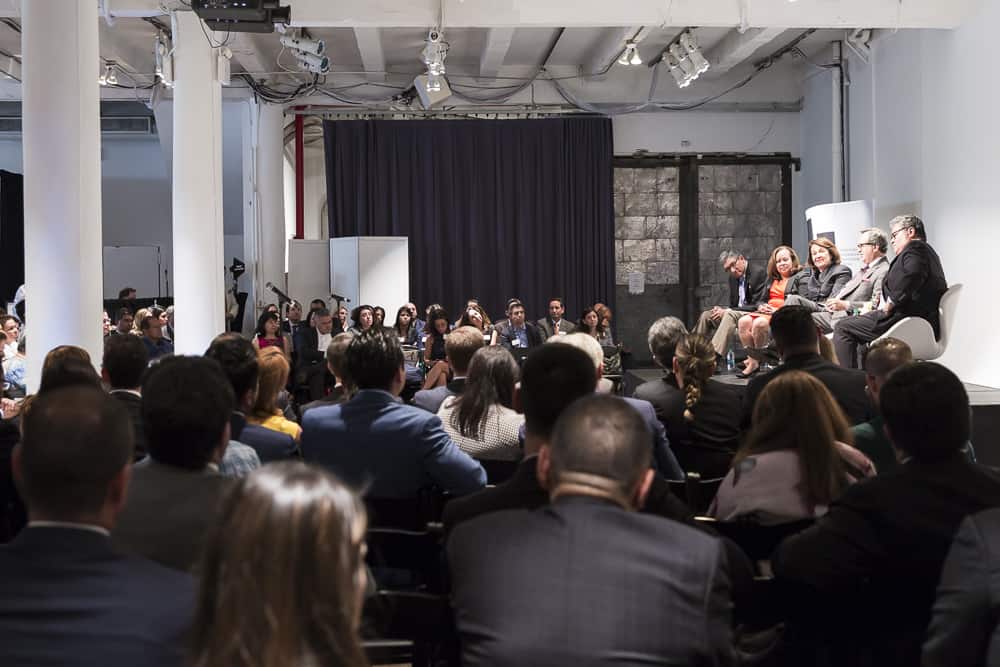Leadership Summit’s Directors Panel Addresses Creating Diverse Boards
Leaders Aída Álvarez, Thomas Castro, Adela Cepeda, and Luis Nieto discuss board membership at The Alumni Society’s 2016 Leadership Summit.
Words by Mary Kenney // Photo by Sheila Barabad

NEW YORK CITY—Board membership has, traditionally, been closed to diverse candidates. But it’s a glass ceiling that can be shattered.
Six Latino leaders in the corporate sphere participated in the directors roundtable panel at The Alumni Society’s second annual Leadership Summit. Aída Álvarez, Thomas Castro, Adela Cepeda, and Luis Nieto participated. Elizabeth Nieto, chief diversity officer of MetLife, hosted the panel, and Victor Arias, previously a member of the board of Popeyes Louisiana Kitchen, served as moderator.
Arias hosted the 2015 panel of speakers at the Society’s Leadership Summit and returned with the humor and insight that impressed guests last year. “From 2011 to 2015, how many people think that total seats on boards have increased?” The overwhelming majority believed they decreased, and Arias confirmed it. “By about 4 percent,” he said. He followed up regarding diversity and said it has improved for both women and Latinos—but for Latinos, only by one-tenth of a percentage.
“Latinos have made very little gain in the boardroom. It remains flat,” Arias says. “That’s the backdrop in which we have this discussion with Latino board members.”
The panel opened with members explaining the paths that led them to the boardroom. They had backgrounds in journalism, business, government, and more. For all of them, an unwillingness to settle and a passion for their causes defined the journey.
As a young businessperson, Castro, today a board member at Time Warner Cable, was told he needed to “befriend a white man” to join a board of directors. It was a flip answer that he laughed at, but as he reflected on it, he realized how true it was.
Álvarez, who now sits on the board of directors at HP and previously was part of the board of Wal-Mart, was told in high school that she needed to train as a secretary, because “girls like her” didn’t go to college. She attended Harvard College.
When Álvarez interviewed for her first board position, she was warned she may not be selected because “they only wanted one woman.” At the end of the nominations, however, the board decided to welcome two women. “You don’t have to go to a C-suite where you’re going to be invisible,” Álvarez says. “We all come from so many walks of life. We need to be open about what we can bring to the table.”
Cepeda, a member of BMO Financial’s board of directors, reflected on the many influences that led her to college. As she grew up, many mentors tutored her in all she needed to do to be a competitive candidate, and she later had to choose between Ivy League admissions. She chose Harvard University.
When she wasn’t immediately admitted to Harvard Business School, Cepeda spoke with an adviser who told her, “Women don’t do as well in quantitative programs.” Cepeda didn’t consider that sexist; she considered it a fact. But she went into the workforce and took the most quantitative job—a career in finance—that she could find.
When boards of financial organizations have wanted to recruit a woman, Cepeda’s name has often come up. But that question was almost never asked about Latinos. “It’s always me saying, ‘I want more Latinos. And shouldn’t we have more women, too?’ ” Cepeda says. “It doesn’t happen silently; somebody has to say it.”
She adds that women are more likely to sit on more than one mutual funds board.
Nieto, who sits on the boards of Ryder System and AutoZone, was asked one crucial question before he was offered his latest board membership: “Cubs or Sox?” He said the board membership was important to him, but not enough to deny that he’s a season ticketholder for the Chicago White Sox. It was the right answer.
Nieto is now retired but does private equity investing for two companies and chairs the board of one of them. He says it’s a completely different world from what he is used to.
After the panelists had introduced themselves and their stories, Arias asked every board member in the room to raise his or her hand. A few shot up. It’s critical, Arias says, for qualified professionals to understand what boards are looking for.
Latinos, women, and African-Americans often aren’t taking all the steps they can to ensure board membership, Cepeda says. “But we still have to be on boards, because these companies are selling to us.”
Álvarez followed up by saying that once you’ve been on one board, you’ve “broken through.” You speak the language, and that makes company leaders elsewhere comfortable with trusting you on their boards, she says. “Cultural fit is just a mind-set.”
“The question is, what are boards looking for?” Castro says. “And the bad news is that for 99 percent of you, the answer is not you, and the answer is never going to be you. Does that mean you shouldn’t be on a board? I say adamantly no.”
He went on to say that an invitation to a board isn’t based on merit; it’s based on how well people know you. You need to make yourself well-known in order to be accepted on a board of directors, he says.
Nieto, who is on the nominating committee of a board, disagreed with Castro that board recruitment happens only if you know people already on the board. “It can certainly help, but it’s not a qualifier,” he says. There are many other paths to the boardroom, including joining the board of a smaller organization, which can lead to Fortune 1,000 and 500 companies.
Arias opened the last twenty minutes of the panel to the audience, taking questions. The first was about the boards of universities. Arias said that was his path to the corporate boardroom.
Castro said that whatever board you serve on, whether for a university or small company, you should be intentional about it. Choose a board where you can display your talents and passion.
“You should do boards that you love,” Cepeda agrees. “I was on the Joffrey [Ballet], and I didn’t know who else was on it. I was just excited about them.”
“If you don’t have passion about the not-for-profit you’re involved in, it’ll be transparent,” Nieto said. “You’ll be introduced to key, influential people, and you won’t be passionate. So if you’re not, take a pass.”
Another audience member asked whether there are certain personalities boards look for. Álvarez said it’s crucial to be genuine because people will always appreciate that. Arias added that boards always need members who can help many people reach one decision.
Arias asked Castro what made him want to serve on a board. “If you’re out there politicking to join a board, that doesn’t look good,” Arias added.
Castro admitted that he had no interest in what he perceived as a bureaucratic system. Now a board member himself, he urges professionals to join the right board, the one that suits their mission and leadership style. Time Warner was looking for someone with an entrepreneurial mind, he adds, which is why he was recruited. Everyone else on the board came from large companies, while his background was in small business.
The panel ended by discussing how mentorship can create more diverse boards of directors, something both professionals and consumers rely on for their nuanced, expert leadership.
“It’s my job to look out for the professionals coming up,” Cepeda says. It’s that mentorship that will continue to promote people of color in the years to come, and improve diversity throughout corporate America and beyond.
Castro adds that this isn’t just an American problem, and it’s a problem that applies to African-Americans and women, as well. “It’s an entrenched issue, that people want to put people on boards who look just like them.
“We have to teach them that we,” Castro says, referring to current diverse board members, “are not the great exception. There are many more people who are qualified and ready to serve on boards.”



